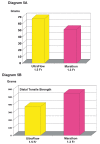Basics and Principles in the Application of Onyx LD Liquid Embolic System in the Endovascular Treatment of Cerebral Arteriovenous Malformations
- PMID: 20584468
- PMCID: PMC3404755
- DOI: 10.1177/15910199050110S117
Basics and Principles in the Application of Onyx LD Liquid Embolic System in the Endovascular Treatment of Cerebral Arteriovenous Malformations
Figures









Similar articles
-
Neurological morbidity and mortality associated with the endovascular treatment of cerebral arteriovenous malformations before and during the Onyx era.J Neurosurg. 2015 Jun;122(6):1492-7. doi: 10.3171/2015.2.JNS131368. Epub 2015 Mar 27. J Neurosurg. 2015. PMID: 25816081
-
Embolic Agents and Microcatheters for Endovascular Treatment of Cerebral Arteriovenous Malformations.World Neurosurg. 2020 Sep;141:383-388. doi: 10.1016/j.wneu.2020.06.118. Epub 2020 Jun 24. World Neurosurg. 2020. PMID: 32592963 Review.
-
Endovascular treatment of cerebral arteriovenous malformations with Onyx embolization.Chin Med J (Engl). 2005 Dec 20;118(24):2041-5. Chin Med J (Engl). 2005. PMID: 16438900
-
A prospective, multicenter, randomized trial of the Onyx liquid embolic system and N-butyl cyanoacrylate embolization of cerebral arteriovenous malformations. Clinical article.J Neurosurg. 2010 Oct;113(4):733-41. doi: 10.3171/2010.3.JNS09370. J Neurosurg. 2010. PMID: 20433277 Clinical Trial.
-
Onyx: a unique neuroembolic agent.Expert Rev Med Devices. 2006 Nov;3(6):705-15. doi: 10.1586/17434440.3.6.705. Expert Rev Med Devices. 2006. PMID: 17280535 Review.
Cited by
-
Transarterial embolization of the external carotid artery in the treatment of life-threatening haemorrhage following blunt maxillofacial trauma.Radiol Oncol. 2020 May 28;54(3):253-262. doi: 10.2478/raon-2020-0035. Radiol Oncol. 2020. PMID: 32463389 Free PMC article. Review.
-
Interventional treatment strategies for arteriovenous malformations of the mandible and maxilla: 30-year institutional case series.Interv Neuroradiol. 2025 May 21:15910199251343000. doi: 10.1177/15910199251343000. Online ahead of print. Interv Neuroradiol. 2025. PMID: 40398476 Free PMC article.
-
In Vitro Quantification of the Radiopacity of Onyx during Embolization.Neurointervention. 2017 Mar;12(1):3-10. doi: 10.5469/neuroint.2017.12.1.3. Epub 2017 Mar 6. Neurointervention. 2017. PMID: 28316864 Free PMC article.
-
State of the Art in the Role of Endovascular Embolization in the Management of Brain Arteriovenous Malformations-A Systematic Review.J Clin Med. 2022 Dec 4;11(23):7208. doi: 10.3390/jcm11237208. J Clin Med. 2022. PMID: 36498782 Free PMC article. Review.
-
Transarterial Embolization for the Management of Brain Arteriovenous Malformations: A Systematic Review.J Neuroendovasc Ther. 2025;19(1):2024-0049. doi: 10.5797/jnet.ra.2024-0049. Epub 2024 Sep 27. J Neuroendovasc Ther. 2025. PMID: 40018288 Free PMC article. Review.
References
-
- Boulos AS, Levy EI, et al. Evolution of neuroendovascular intervention: A review of advancement in device technology. Neurosurgery. 2004;54:438–453. - PubMed
-
- Florio F, Lauriola W, et al. Endovascular treatment of intracranial arterio-venous malformations with Onyx embolization: preliminary experience. Radiol Med. 2003;106:512–520. - PubMed
-
- Howington JU, Kerber CW, et al. Liquid embolic agents in the treatment of intracranial arteriovenous malformations. Neurosurg Clin N Am. 2005;16:355–363. - PubMed
-
- Jahan R, Murayama Y, et al. Embolization of arteriovenous malformations with Onyx: clinicopathological experience in 23 patients. Neurosurgery. 2001;48:984–985. - PubMed
-
- Song D, Leng B, et al. Onyx in the treatment of large and giant aneurysms and arteriovenous malformations. Chines Medical Jounal. 2004;117:1869–1872. - PubMed
LinkOut - more resources
Full Text Sources
Other Literature Sources
Research Materials

